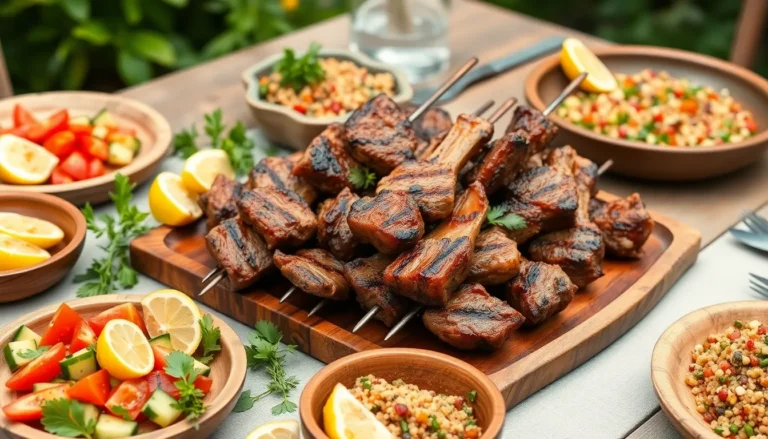When it comes to holiday feasts or Sunday dinners, nothing quite steals the show like a HoneyBaked ham. This succulent centerpiece not only tantalizes taste buds but also brings everyone together around the table, sharing stories and laughter. But let’s be real—cooking this glorious ham can feel like a culinary high-wire act. Fear not!
Table of Contents
ToggleOverview of Honeybaked Ham
HoneyBaked ham serves as a centerpiece for holiday feasts and Sunday dinners. This delicious dish combines sweet, smoky flavors with a succulent texture that pleases many palates. Cooking HoneyBaked ham requires attention to detail, ensuring that each slice remains juicy and flavorful.
Preparation involves preheating the oven to 275°F (135°C). A cooking time of about 15-18 minutes per pound guarantees optimal results. The ham comes fully cooked, so reheating it without drying it out is crucial. Placing the ham in a shallow roasting pan and covering it loosely with foil prevents the outside from becoming overly crispy.
Glazing enhances appearance and flavor. Many prefer to apply glaze during the final 30 minutes of cooking. A generous coating adds a fantastic caramelization while locking in moisture. Remember to baste the ham periodically to keep it tender.
Serving HoneyBaked ham offers versatility. It pairs well with sides like roasted vegetables, creamy potatoes, or green beans. Sandwiches made from leftovers provide a quick and tasty meal option, showcasing the ham’s rich flavor.
Understanding the steps and maintaining the right temperatures ensures a satisfying culinary experience. Following these tips leads to a perfect HoneyBaked ham that impresses family and friends alike.
Essential Ingredients
Selecting the right ingredients enhances the flavor and presentation of HoneyBaked ham. Quality ingredients contribute to the overall enjoyment of the dish.
Ham Selection
Choose a bone-in, fully cooked ham for optimal flavor. Many prefer a spiral-cut option for ease of serving and a great appearance. Look for hams that weigh between 8 to 12 pounds, which are ideal for family gatherings. Depending on preference, variations such as honey-glazed or smoked options can elevate taste further. Ensure the ham has a rich, marbled texture; this indicates juiciness when cooked.
Glaze Options
Utilizing a glaze adds a delicious, glossy finish to the ham. Popular choices include honey, brown sugar, and Dijon mustard blends for a sweet and tangy profile. Some enjoy a pineapple glaze for fruity undertones, while others prefer a maple syrup infusion for added sweetness. Another option entails using a bourbon glaze for those who like a bold flavor. Experimenting with these glazes not only enhances taste but also adds visual appeal to the final dish.
Cooking Methods
Cooking methods for HoneyBaked ham include oven baking and slow cooking, each offering unique benefits that enhance flavor and texture. Understanding these methods helps achieve a delicious result.
Oven Baking
Oven baking provides a familiar and effective way to prepare HoneyBaked ham. Preheating the oven to 275°F (135°C) creates an ideal cooking environment. Cooking time ranges from 15 to 18 minutes per pound, ensuring the meat remains juicy. Applying glaze during the last 30 minutes of cooking adds flavor and a glossy finish. Covering the ham with aluminum foil prevents drying while allowing the glaze to caramelize. Using a meat thermometer to check for an internal temperature of 140°F (60°C) guarantees thorough cooking, resulting in a tender and flavorful dish ready to serve.
Slow Cooking
Slow cooking offers an alternative method for preparing HoneyBaked ham that simplifies meal preparation. Using a slow cooker allows the flavors to meld beautifully over time. Setting the slow cooker on low for 5 to 7 hours is generally effective for heating a fully cooked ham. Incorporating a small amount of liquid, such as apple juice or broth, enhances moisture and flavor. Basting the ham with glaze during the cooking process adds complexity and visual appeal. This method results in a delectably tender ham, perfect for gatherings or family dinners.
Serving Suggestions
Serving HoneyBaked ham with the right accompaniments enhances the overall meal experience.
Side Dishes
Classic side dishes pair beautifully with HoneyBaked ham. Consider roasted seasonal vegetables, which add color and nutrition to the plate. Scalloped potatoes bring a creamy texture that complements the ham’s smokiness. Green bean casserole provides crunch and flavor, balancing the ham’s sweetness. Baked mac and cheese serves as a hearty option, appealing to both adults and kids. For a refreshing contrast, a simple salad with mixed greens and a light vinaigrette brightens the meal. Sweet potato casserole introduces fall flavors, making it a seasonal favorite.
Presentation Tips
Presentation significantly impacts the dining experience. Start with a large serving platter to showcase the HoneyBaked ham. Arrange the slices in a fan shape for visual appeal, highlighting the spiral cuts. Garnish with fresh herbs, such as rosemary or parsley, to add a pop of color. Place sliced fruits like oranges or pineapples around the ham, enhancing the sweet aroma and flavor. Use decorative serving utensils to elevate the aesthetic further. Keep the table setting elegant with complementary dishware and linen, creating a warm atmosphere for guests.
Preparing a HoneyBaked ham can transform any meal into a memorable occasion. With the right techniques and attention to detail, anyone can achieve a beautifully glazed ham that’s bursting with flavor. Whether opting for traditional oven baking or the convenience of slow cooking, it’s essential to monitor the temperature and apply glaze at the right moment for that perfect finish.
Pairing the ham with complementary sides enhances the overall dining experience. From classic green bean casserole to rich scalloped potatoes, the options are endless. With a little creativity in presentation and thoughtful serving, HoneyBaked ham will undoubtedly impress and delight all who gather around the table.


